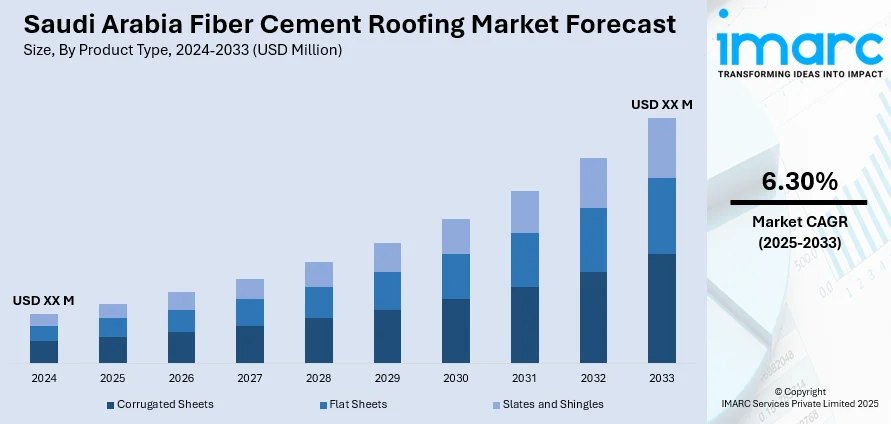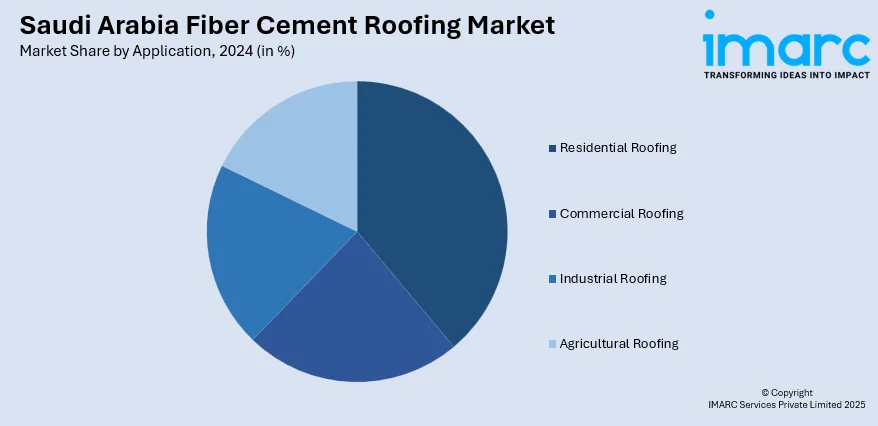
Saudi Arabia Fiber Cement Roofing Market Size, Share, Trends and Forecast by Product Type, Material Composition, Application, End Use Sector, and Region, 2025-2033
Saudi Arabia Fiber Cement Roofing Market Overview:
The Saudi Arabia fiber cement roofing market size is projected to exhibit a growth rate (CAGR) of 6.30% during 2025-2033. The market is majorly driven by the rising demand for thermally resilient and low-maintenance roofing materials that endure desert climates and structural stress. In parallel, the Vision 2030 infrastructure developments are fueling the adoption of durable, prefabrication-friendly roofing in large-scale public and private construction. Growing alignment with sustainability codes and resource efficiency standards is accelerating material adoption, further augmenting the Saudi Arabia fiber cement roofing market share.
|
Report Attribute
|
Key Statistics
|
|---|---|
|
Base Year
|
2024
|
|
Forecast Years
|
2025-2033
|
|
Historical Years
|
2019-2024
|
| Market Growth Rate 2025-2033 | 6.30% |
Saudi Arabia Fiber Cement Roofing Market Trends:
Demand for Durable, Heat-Resistant Construction Materials
Saudi Arabia's harsh desert climate, marked by extreme heat, sandstorms, and minimal precipitation, necessitates the use of thermally stable and structurally resilient roofing materials. High temperatures exceeding 45°C have been shown to reduce worker productivity by up to 35%, while sandstorms and rare heavy rainfall disrupt construction activities and cause equipment maintenance challenges, underscoring the need for materials that can endure these conditions without compromising performance. Fiber cement roofing is increasingly favored for its ability to withstand temperature fluctuations, UV radiation, high winds, and environmental stresses without cracking or degrading. It offers a long operational lifespan, resists rot and termites, and maintains structural integrity under sustained heat exposure, characteristics essential for both residential and non-residential applications in the Kingdom. In fast-growing cities such as Riyadh and Jeddah, architects prioritize materials that reduce heat ingress and cooling loads, helping manage indoor energy efficiency. Additionally, fiber cement roofs do not combust or emit toxic gases, contributing to improved building safety in arid regions prone to sudden electrical fires. This demand aligns with the construction sector’s efforts to meet both resilience and efficiency criteria without recurring maintenance issues. Contractors and developers are increasingly selecting fiber cement over conventional roofing due to its performance reliability and lifecycle advantages. These features are directly linked to Saudi Arabia fiber cement roofing market growth, particularly as material quality expectations rise across both government-backed and private construction initiatives.

Sustainability, Water Efficiency, and Non-Toxic Construction Trends
In line with its broader environmental commitments, Saudi Arabia is introducing building codes and certification frameworks that promote sustainable material use and reduced ecological impact. Fiber cement roofing offers a viable alternative to water-intensive materials and energy-intensive metal sheets, helping conserve vital resources. Manufactured with low-toxicity binders and inert fillers, it poses minimal environmental and health risks during both construction and disposal. The material's long lifecycle reduces waste generation, aligning with circular economy goals and the national ambition to reduce construction-related landfill volumes and CO₂ emissions. Saudi Arabia aims to reduce CO₂ emissions by 278 mtpa by 2030. Developers targeting green certifications under the Saudi Building Code or seeking approval for environmentally certified projects are increasingly specifying fiber cement roofing. Green construction practices in Saudi Arabia are reducing emissions from the construction industry, which accounts for 38% of national CO₂ output, with LEED Gold buildings using 30% less energy. Furthermore, innovative sustainable materials are emerging that enhance construction durability and performance. Additionally, the shift toward net-zero buildings in commercial and public sectors is creating demand for roof materials that support energy performance and integrate with passive cooling strategies. With fiber cement’s adaptability to energy-efficient designs and minimal operational emissions, the material is becoming a standard in sustainable construction practices. These ecological and regulatory drivers are reinforcing its role in high-compliance builds, substantially contributing to the market growth within a sustainability-focused construction landscape.
Saudi Arabia Fiber Cement Roofing Market Segmentation:
IMARC Group provides an analysis of the key trends in each segment of the market, along with forecasts at the country and regional levels for 2025-2033. Our report has categorized the market based on product type, material composition, application, and end use sector.
Product Type Insights:
- Corrugated Sheets
- Flat Sheets
- Slates and Shingles
The report has provided a detailed breakup and analysis of the market based on the product type. This includes corrugated sheets, flat sheets, and slates and shingles.
Material Composition Insights:
- Asbestos Fiber Cement
- Non-Asbestos Fiber Cement
The report has provided a detailed breakup and analysis of the market based on the material composition. This includes asbestos fiber cement and non-asbestos fiber cement.
Application Insights:

- Residential Roofing
- Commercial Roofing
- Industrial Roofing
- Agricultural Roofing
The report has provided a detailed breakup and analysis of the market based on the application. This includes residential roofing, commercial roofing, industrial roofing, and agricultural roofing.
End Use Sector Insights:
- New Construction
- Replacement and Renovation
The report has provided a detailed breakup and analysis of the market based on the end use sector. This includes new construction and replacement and renovation.
Regional Insights:
- Northern and Central Region
- Western Region
- Eastern Region
- Southern Region
The report has also provided a comprehensive analysis of all major regional markets. This includes Northern and Central Region, Western Region, Eastern Region, and Southern Region.
Competitive Landscape:
The market research report has also provided a comprehensive analysis of the competitive landscape. Competitive analysis such as market structure, key player positioning, top winning strategies, competitive dashboard, and company evaluation quadrant has been covered in the report. Also, detailed profiles of all major companies have been provided.
Saudi Arabia Fiber Cement Roofing Market Report Coverage:
| Report Features | Details |
|---|---|
| Base Year of the Analysis | 2024 |
| Historical Period | 2019-2024 |
| Forecast Period | 2025-2033 |
| Units | Million USD |
| Scope of the Report |
Exploration of Historical Trends and Market Outlook, Industry Catalysts and Challenges, Segment-Wise Historical and Future Market Assessment:
|
| Product Types Covered | Corrugated Sheets, Flat Sheets, Slates and Shingles |
| Material Compositions Covered | Asbestos Fiber Cement, Non-Asbestos Fiber Cement |
| Applications Covered | Residential Roofing, Commercial Roofing, Industrial Roofing, Agricultural Roofing |
| End Use Sectors Covered | New Construction, Replacement and Renovation |
| Regions Covered | Northern and Central Region, Western Region, Eastern Region, Southern Region |
| Customization Scope | 10% Free Customization |
| Post-Sale Analyst Support | 10-12 Weeks |
| Delivery Format | PDF and Excel through Email (We can also provide the editable version of the report in PPT/Word format on special request) |
Key Questions Answered in This Report:
- How has the Saudi Arabia fiber cement roofing market performed so far and how will it perform in the coming years?
- What is the breakup of the Saudi Arabia fiber cement roofing market on the basis of product type?
- What is the breakup of the Saudi Arabia fiber cement roofing market on the basis of material composition?
- What is the breakup of the Saudi Arabia fiber cement roofing market on the basis of application?
- What is the breakup of the Saudi Arabia fiber cement roofing market on the basis of end use sector?
- What is the breakup of the Saudi Arabia fiber cement roofing market on the basis of region?
- What are the various stages in the value chain of the Saudi Arabia fiber cement roofing market?
- What are the key driving factors and challenges in the Saudi Arabia fiber cement roofing market?
- What is the structure of the Saudi Arabia fiber cement roofing market and who are the key players?
- What is the degree of competition in the Saudi Arabia fiber cement roofing market?
Key Benefits for Stakeholders:
- IMARC’s industry report offers a comprehensive quantitative analysis of various market segments, historical and current market trends, market forecasts, and dynamics of the Saudi Arabia fiber cement roofing market from 2019-2033.
- The research report provides the latest information on the market drivers, challenges, and opportunities in the Saudi Arabia fiber cement roofing market.
- Porter's five forces analysis assist stakeholders in assessing the impact of new entrants, competitive rivalry, supplier power, buyer power, and the threat of substitution. It helps stakeholders to analyze the level of competition within the Saudi Arabia fiber cement roofing industry and its attractiveness.
- Competitive landscape allows stakeholders to understand their competitive environment and provides an insight into the current positions of key players in the market.
Need more help?
- Speak to our experienced analysts for insights on the current market scenarios.
- Include additional segments and countries to customize the report as per your requirement.
- Gain an unparalleled competitive advantage in your domain by understanding how to utilize the report and positively impacting your operations and revenue.
- For further assistance, please connect with our analysts.
 Request Customization
Request Customization
 Speak to an Analyst
Speak to an Analyst
 Request Brochure
Request Brochure
 Inquire Before Buying
Inquire Before Buying




.webp)




.webp)












